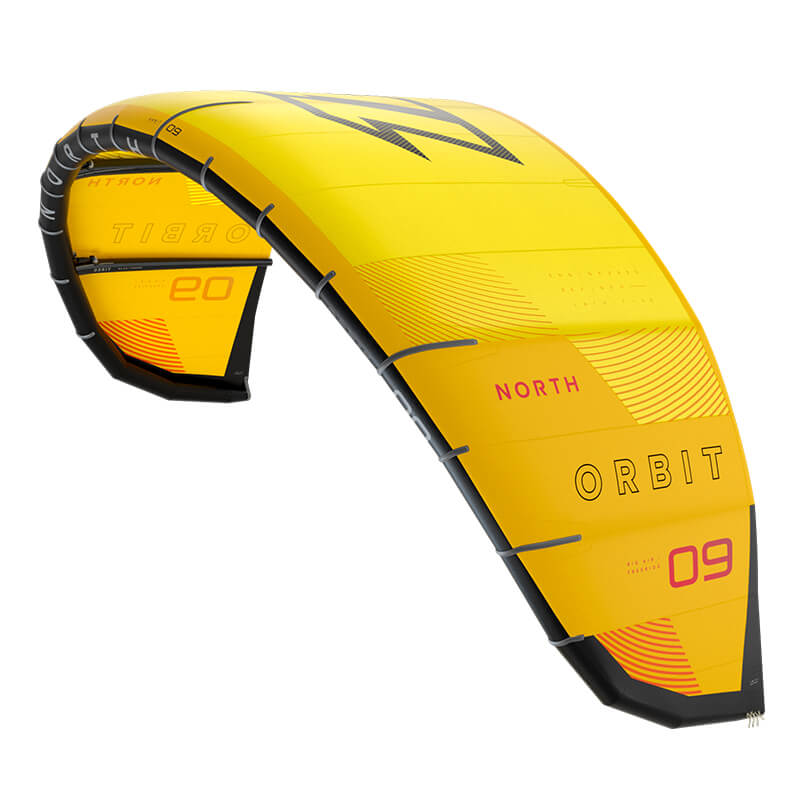When you purchase gear through links on our site, we may earn a small commission. Here’s why you can trust our tests and our affiliate partner.

The Orbit is a kite that now requires zero introduction. It has quickly become an iconic kite synonymous with Big Air, the winner of more podiums in the last few years than anything else we can recall, as well as Colin’s infamous recent Big Air blank kite test. An open arced, higher aspect five-strut affair with its signature gently curved tips and lifty profile are the usual key ingredients, and the 2023 model has built on that (literally) winning formula. For 2023 there’s been some significant tweaks which result in quite a markedly different feeling to the Orbit.
Technical upgrades this year include an all new N-Dure Dacron which lightens and stiffens the airframe across the entire size range. This lightens bar pressure slightly from the previous model and improves the reaction speed of the kite with a noticeably eager initiation of turning. You can see how this has the potential to open up double and S loops; this ability has been well documented by the North team riders. The bridle has had some minor adjustment for more reliability in gusty and unstable wind conditions, enabling you to hold down a ridiculous amount of power with a high level of control. It dampens feedback in gusty conditions; it’s like built-in suspension which is impressive for a kite without pulleys.
Predictability in extreme conditions has historically been the Orbit’s most endearing and important feature, and the 23 version extends this even further. We took the 9m into the 35-40 knot region without it looking or feeling even slightly flustered. The occasional wingtip instability of the first Orbit is now a long-forgotten memory and North have utilized some clever CAD trickery to smooth out any inconsistencies in the canopy. The result is a kite with less drag and more speed and efficiency; this is most noticeable where the leading edge profile fades into the front of canopy where new seaming is present. The trailing edge has also been reworked to a double layer of canopy material from Dacron to lighten the back end of the kite, but maintain strength. Lighter bladders have been employed in the larger sizes of the range to reduce weight, where it’s perhaps most important to.
General handling is quite assertive and rapidly builds an intuitive connection between you and the Orbit. It quickly becomes almost an extension of your body and doesn’t take ages to dial into. The other good news is that the bar pressure doesn’t increase significantly with wind strength, giving a creamy consistency to the handling over its range. The increase in turning speed translates into a more aggressive initiation in your jump, with the kite hooking itself up and across the window more assertively. This gives a more instant directional change and more grabby vertical lift. After lobbing a tasty loop, the Orbit retains that fabulous ability to fly forward and catch you alarmingly reliably.
The Orbit absolutely motors upwind, which is an important factor when the magnitude of your jumps will inevitably propel you a long way in the opposite direction. Unusually for a Big Air number, it does this fairly passively with the bar out, without you having to really lock an edge in and sheet like a lunatic, giving you the opportunity to give your legs a breather before you load up for the next aerial endeavor.
Four steering settings are present which we had a good fiddle with. The outermost ‘megaloop’ setting spices things up significantly, increasing turning speed and making the power band over the range of the bar throw far more concise. This turning setting also seems to whip the kite round to catch you a little faster. It’s not all about extremities though; the Orbit’s inside ‘cruise’ mode is ideal for the more tame old-school rider who wants to throw a few spins and board offs without rupturing any ligaments, moderating the turning speed and extending the throw a little for big lofty jumps and mellow landings where you can simply sheet in pre-touchdown. This is also a telling situation for how stable the kite is, with no overflying if landing a lofty, straight old-school jump, perhaps broadening the Orbit’s appeal to a wider section of the freeride market without losing its bleeding edge performance and competition potential. You don’t necessarily need to be Marc Jacobs to enjoy it.
Technically the Orbit is now honed to near perfection, with a notable increase in forward speed and slightly more lift. It has more accessibility than ever and is steadier in all situations. With the Big Air genre becoming increasingly technical and dangerous, it’s exactly what the orthopedic specialist ordered, being both predictable and performant in equal measure, allowing you to really push your Big Air riding and progress with confidence. It brings a desirable modicum of order to the often chaotic environment of high-wind kiting.
